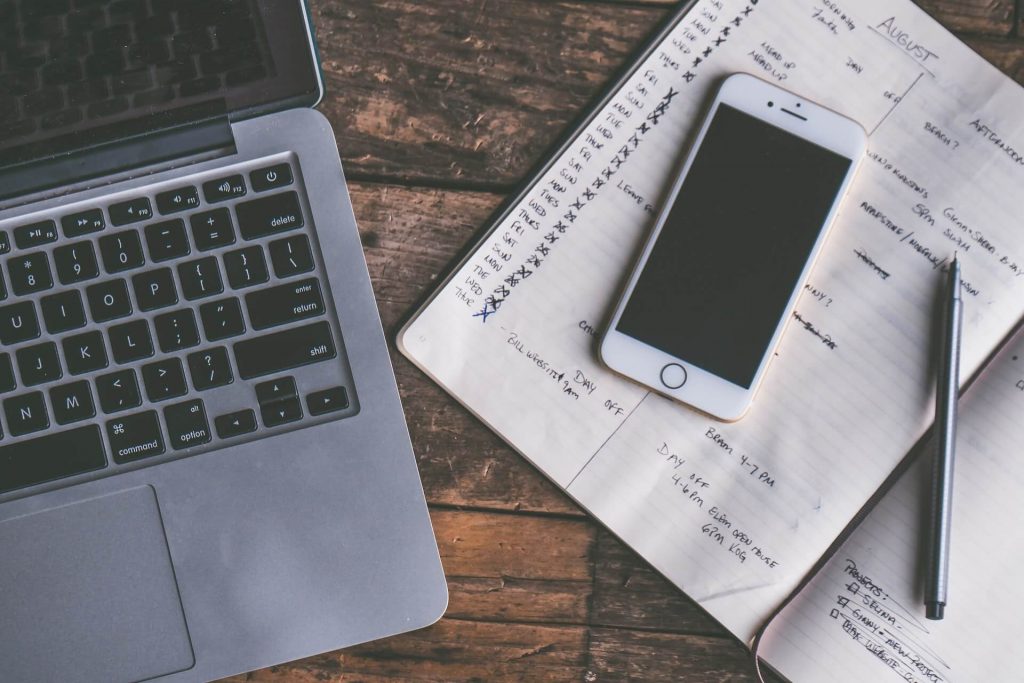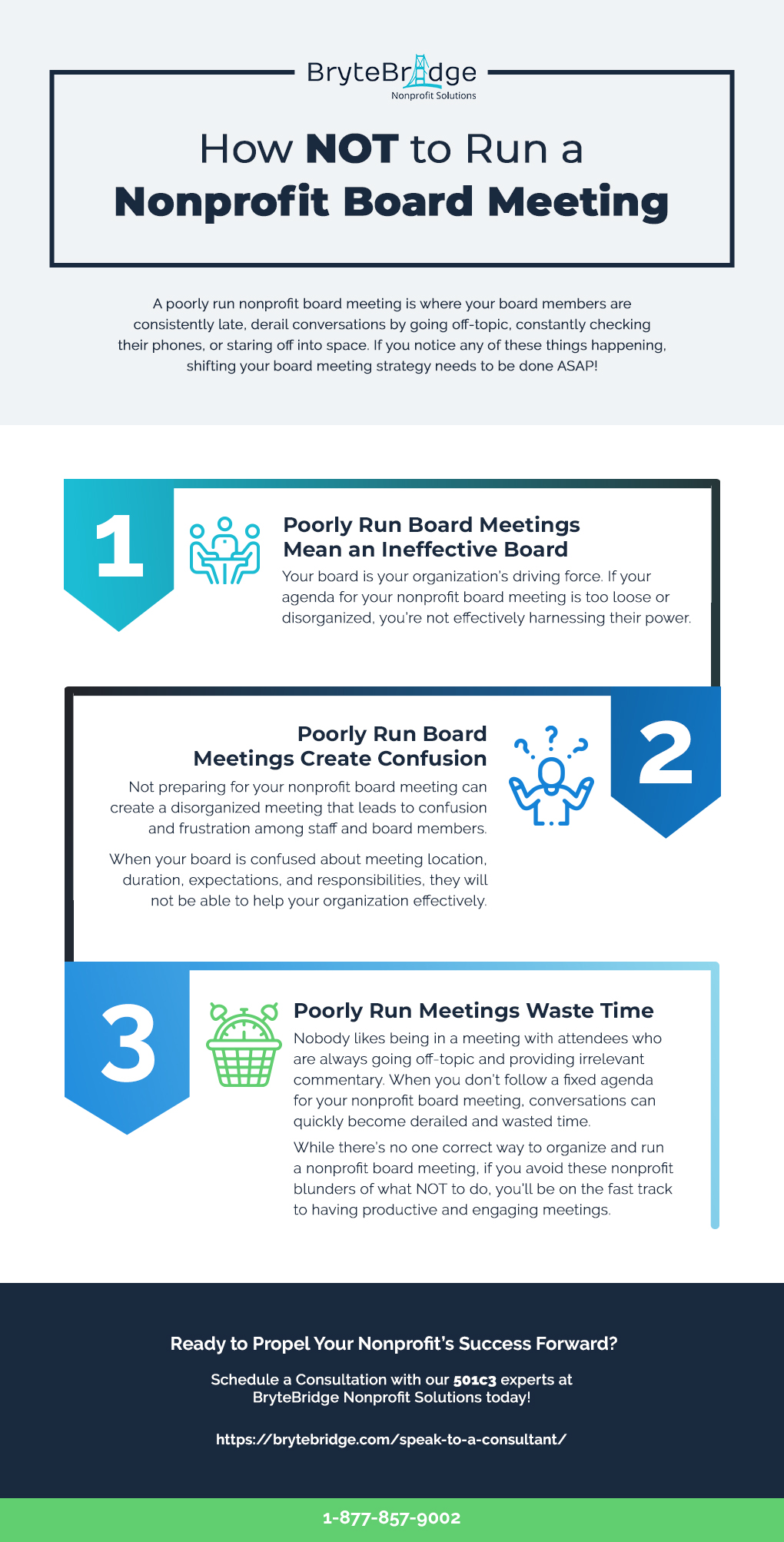Everything you need for nonprofit board meetings, committees, and planning sessions
Learning how to create an agenda for your nonprofit board meeting can help eliminate uncertainty and improve your nonprofit’s performance. When run in an organized and coherent manner, nonprofit board meetings can bring your organization closer to achieving its goals. In addition, an engaged and active board can also provide enthusiasm to your donors, staff, volunteers, and the communities you serve. Taking time to plan carefully is worth it one hundred times over!
How to Run a Nonprofit Board Meeting in Five Easy Steps
1. Prepare the Agenda for a Your Nonprofit Board Meeting in Advance
A month before your nonprofit’s board meeting is scheduled to happen, send out a “save the date” reminder announcement to all members providing information about the location of the meeting, start time, and any other particulars. Then, one week before the meeting, send out another reminder email containing the meeting’s agenda. Sending out the agenda for the nonprofit’s board meeting in advance is essential because board members will want to look at the document and familiarize themselves with the discussion topics in advance.
When putting together your agenda, it’s always a good idea to write your organization’s mission statement at the very top. The mission provides a point of direction, as all discussions and decisions during the nonprofit’s board meeting should be focused on driving that mission forward.
In addition to this agenda, you’ll also want to pull together any necessary reports or financial documents that the board members may need to familiarize themselves with before arriving at the meeting.
2. Start and End Your Meeting on Time.
One of the most important rules for how to run a nonprofit board meeting successfully is sticking to time! Board members tend to be busy, so set a precedent of starting and ending on time, even if someone is running late. In addition, make sure that your agenda for the nonprofit’s board meeting can be covered in under two hours. This is especially true if your nonprofit’s board meetings occur in the evening. You always want to make sure your members stay alert and engaged, so offering refreshments such as coffee, tea, bottled water, or soft drinks, plus an assortment of light snacks, is always a good idea.
3. Remember, Nonprofit Board Meetings Are About Decisions.
Your board members are a precious resource, and you don’t want to waste their time. Your agenda for the nonprofit’s board meeting should be organized so that board members spend most of their time focusing on important decisions and strategic planning. Program updates and staff reports are helpful, but they should be limited to only the first 10 or 15 minutes of the meeting. Your nonprofit’s board meetings should always focus on long and short-term strategic goals and how board members can contribute to the organization’s success.
4. Take Good Meeting Minutes.
Having someone who can take comprehensive minutes of your nonprofit board meeting is helpful. The most organized way to do this is to get a copy of the board meeting agenda and take notes using it as a guide. Be sure to include all actions, decisions, and which board members agreed or volunteered to have tasks assigned to them.
Organization is the key to learning how to run a nonprofit board meeting successfully, so be sure to distribute the minutes to all board members within 24-48 hours after each meeting. Taking quick, organized actions will ensure that the assignments and action items are firmly in everyone’s mind.
And as a bonus, meeting minutes make it much easier when preparing your agenda for the following nonprofit board meeting.
5. Select a Strong Board Chair
Creating an organized and strategically focused agenda for your nonprofit board meeting is vital, but so is selecting a solid board chair. Your chair is the person who keeps the discussion moving, and they must have experience and knowledge of your nonprofit as well as the social and organizational skills to run meetings effectively.
A board chair needs to have the ability to focus and steer discussions and recognize good suggestions when raised by board members. A strong board chair will help balance contributions from both extroverts and introverts to ensure that all members have their say and are recognized for their contributions and skills.

Bonus Tips for How to Run a Nonprofit Board Meeting
- Make sure everyone has a name tag! This alleviates any uncertainty or uncomfortableness and helps new board members immediately feel welcomed.
- Make refreshments available. Having a selection of coffee, tea, bottled water, soda, and light snacks will be appreciated. This gives board members a chance to socialize a bit before or after the meeting and have a light bite to eat.
- Measure your nonprofit’s board meeting effectiveness. Distributing evaluation forms after each board meeting can provide you with valuable feedback on how well the meeting achieved its goals. In addition, a post-meeting evaluation helps you see what went well and correct any problems that arose quickly.
- Send personalized thank you messages. A personalized ‘thank you’ email should be sent to each board member within a few days after the meeting. The sender of this message can be the board’s chair or the organization’s executive director.
Final Thoughts on Creating an Effective Agenda for Your Nonprofit’s Board Meeting
All of your nonprofit’s board meetings are important because they allow you to improve your outreach strategies and management procedures and address any risks or compliance violations. In addition, board members are mission-critical when fundraising and being public champions for the organization.
Whether your 501(c)(3) is new or well established, large or small, the responsibilities of board members are significant, and it’s important that each meeting be maximized for effectiveness. The tool for doing that is the nonprofit board meeting agenda. Spend your time to craft it thoughtfully, and your engagement, productivity, and participation will soar!




